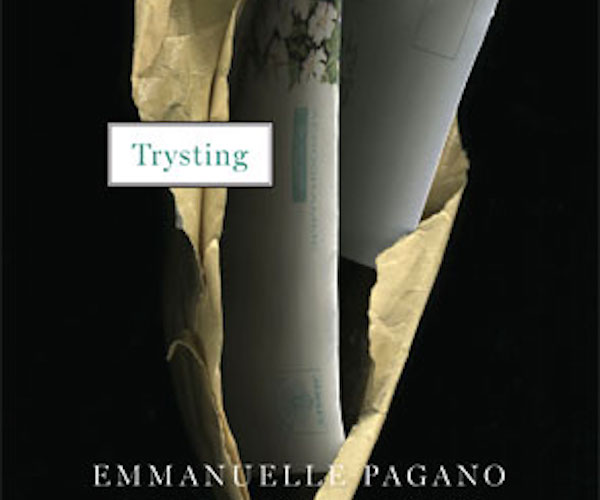Book Review: Getting coupled and uncoupled — Emmanuelle Pagano’s Mini-Studies of Love
A perspicacious, multifarious, and compelling fictional field report on how we get hitched or unhitched, coupled or uncoupled.
Trysting by Emmanuelle Pagano. Translated by Jennifer Higgins and Sophie Lewis. Two Lines Press, 155 pp., $14.95.

By John Taylor
Trysting is the title cleverly employed by Jennifer Higgins and Sophie Lewis to render the punning and visually droll French title, Nouons-nous (2013), which nicely ties up, in a semantically resonant bundle, Emmanuelle Pagano’s collection of very short untitled prose texts about couples. The verb “nouer” indeed means “to tie” or “to knot” (and several other ways of joining things or people together), so the witty French title literally means—if one stretches one’s metaphorical imagination a bit—something like “Let’s tie each other up” or, perhaps more pertinently, “Let’s make a knot out of ourselves.” Or, of course: “Let’s bond,” “Let’s start up a relationship.” The French noun for “knot” also means “bonds” (of friendship) in an expression like “les nœuds de l’amitié” and “the crux” (of the problem) in “le nœud du problème.”
Lots of trysts and knots and bonds, not to mention “cruxes of the problem,” are brought to light in these vivid and thought-provoking mini-narratives that range in length from a single sentence to a page or two. Pagano takes revealing snapshots, as it were, of couples of all kinds, both hetero and homo—though you rarely know the specific configuration and, in fact, it’s unimportant to know. The author is exploring the universals of amorous sentiment through the particulars of countless twosomes—married or not, living together or not, some even unknown to each other yet nonetheless caught up in a mutual or one-sided attraction. Here’s one of those universals, encapsulated in a single image: “All I did was observe him on the sly, the man next door to my life.” And another one: “All these moments when I’m alone but walking toward her, all these mornings when I’ll be with her in a few kilometers, a few hours.”
Such strong feelings, withheld by the character, are left unnamed by the author; the reader also feels them strongly, empathizes with them, even if he cannot assign a single name to them. The book is constantly effective in this way, guiding us back into the elemental, bodily, not-yet-voiced realities of feeling instead of keeping us on the analytical level. Some texts offer brief descriptions that represent more intricate, complex emotions that are similarly left undefined and are associated with getting along with one’s beloved in everyday life:
Because she’s so short, she never stands with her feet flat on the floor of my apartment. When she needs to open a cupboard or take something off a shelf she stands on tiptoe, a ballet dancer delivered to my door. Sometimes that isn’t enough, so she perches on stools, chairs, tables, the bathtub, or the bed. She climbs around the place using door handles, window ledges, and open drawers as handrails.
Several compelling short shorts fill out the volume. The most poignant one is that of a woman who, after her husband’s death, goes to his office to sort out his things. “I’d always known there was another woman, right from the start,” she admits, “but I never said anything. [. . .] When he died, though, I wanted to know who she was and if I knew her.” Her investigation culminates in the unexpected discovery of a trunk full of love letters that were never sent to the woman, who, in fact, never existed.
In these comparatively longer narratives, which remain very short by most short-story standards, as well as in her striking vignettes, Pagano catches the telltale habit, scene, memory or reaction that indicates so much more than can be stated about the past or present of a couple. In brief, she pinpoints what works in the relationship, or vaguely works, or has stopped working—those behavioral functions and dysfunctions that are alive, dying, dead, or coming back to life. Elsewhere, she unveils only how a relationship was sparked and leaves the rest—the flare or the flame—to the reader’s imagination:
I met him when I called a wrong number. His voice was so lovely, saying I must have made a mistake, that I couldn’t bring myself to hang up.
Because Pagano is so skilled, through her precise evocations of objects and objective acts, at conjuring up the deep emotions that construct (or disrupt) amorous attachment, one thinks of T. S. Eliot’s observation, in his essay “Hamlet and His Problems” (The Sacred Wood, 1921): “The only way of expressing emotion in the form of art is by finding an ‘objective correlative’; in other words, a set of objects, a situation, a chain of events which shall be the formula of that particular emotion; such that when the external facts, which must terminate in sensory experience, are given, the emotion is immediately evoked.” Pagano’s mastery of this specific literary technique—and such realism is rather rare in contemporary French literature—explains why her perspicacious, multifarious fictional field report on how we get hitched or unhitched, coupled or uncoupled, is so compelling.
John Taylor has recently translated Pierre Chappuis’s poetry (Like Bits of Wind) and Catherine Colomb’s novel The Spirits of the Earth—both books available from Seagull. He is the author of the three-volume Paths to Contemporary French Literature (Transaction). His most recent collections of poetry and short prose are The Apocalypse Tapestries (Xenos Books) and If Night is Falling (Bitter Oleander Press). John Taylor’s website.
Tagged: Emmanuelle Pagano, Jennifer Higgins, Sophie Lewis, Trysting
